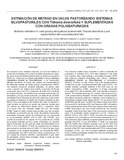Mostrar el registro sencillo del ítem
Estimación de metano en vacas pastoreando sistemas silvopastoriles con Tithonia diversifolia y suplementadas con grasas polinsaturadas
| dc.rights.license | http://creativecommons.org/licenses/by-nc-sa/3.0/ve/ | es_VE |
| dc.contributor.author | Cardona-Iglesias, Juan Leonardo | |
| dc.contributor.author | Mahecha-Ledesma, Liliana | |
| dc.contributor.author | Angulo-Arizala, Joaquín | |
| dc.date.accessioned | 2019-11-12T14:30:58Z | |
| dc.date.available | 2019-11-12T14:30:58Z | |
| dc.date.issued | 2019 | |
| dc.identifier.issn | 0798-2259 | |
| dc.identifier.uri | http://www.saber.ula.ve/handle/123456789/46223 | |
| dc.description.abstract | Se evaluaron cinco modelos empíricos con el fin de estimar la producción de metano (CH 4 ) a partir de datos obtenidos en campo, de vacas lecheras Holstein pastoreando un sistema silvopastoril (SSP) con botón de oro (Titonia diversifolia) y kikuyo Cenchrus clandestinus (Hochst. ex Chiov.)Morrone) o un monocultivo (MONO) de kikuyo en trópico alto, ambos con suplementación de diferentes fuentes de ácidos grasos polinsaturados (AGPI). Los modelos incluyeron variables obtenidas en campo, tales como: consumo de materia seca (CMS), proporción de forraje consumido, peso vivo (PV), producción de leche (PL) y factores de emisión teóricos. Se analizaron las variables gramos (g) CH 4 / animal/(d) y g CH 4 /(L) leche producida. Los datos de las variables estudiadas fueron tomados durante dos pastoreos (rotaciones), se analizaron mediante un diseño de bloques completos al azar (BCA). Para la escogencia del modelo que mejor se ajustara a cada variable, se tuvieron en cuenta los menores valores para los criterios de información Akaike (AIC) y bayesiano (BIC) y el menor valor del cuadrado medio del error del modelo (CME). Según el mejor modelo seleccionado para las variables analizadas, se encontró que las vacas del sistema monocultivo presentaron menores valores de producción de CH 4 expresada en g-CH 4 /animal/d (MONO: 314 vs SSP: 322 P<0,05), pero cuando se expresaron los valores en CH 4 producido por unidad de producto obtenido (g-CH 4 /L leche producida), se encontró menor producción de CH 4 para las vacas que pastoreaban en el SSP: 11,4 vs 12,5 MONO, P<0,05. Se concluye que los modelos que incluyeron variables como el CMS y PL, fueron los que mejor se ajustaron a las variables estudiadas. Los animales del SSP y suplementados con AGPI mostraron menor producción de CH 4 por unidad de producto obtenido, concediéndole a esta clase de estrategias nutricionales bondades desde el punto de vista ambiental y productivo. | es_VE |
| dc.language.iso | es | es_VE |
| dc.publisher | SaberULA | es_VE |
| dc.rights | info:eu-repo/semantics/openAccess | es_VE |
| dc.subject | Modelos predicción metano | es_VE |
| dc.subject | Sistema silvopastoril | es_VE |
| dc.subject | Tithonia diversifolia | es_VE |
| dc.title | Estimación de metano en vacas pastoreando sistemas silvopastoriles con Tithonia diversifolia y suplementadas con grasas polinsaturadas | es_VE |
| dc.title.alternative | Methane estimation in cows grazing silvopastoral systems with Tithonia diversifolia a and supplemented with polyunsaturated fats | es_VE |
| dc.type | info:eu-repo/semantics/article | es_VE |
| dc.description.abstract1 | Five empirical models were evaluated in order to estimate the production of methane (CH 4 ) from data obtained in the field, from Holstein dairy cows grazing a silvopastoral system (SSP) with buttercup (Tithonia diversifolia) and kikuyo Cenchrus clandestinus (Hochst. ex Chiov.)Morrone) or monoculture (MONO) of kikuyo in high tropics, both with supplementation of different sources of polyunsaturated fatty acids (PUFA). The models included variables obtained in the field, such as: dry matter consumption (CMS), proportion of forage consumed, live weight (PV), milk production (MP) and theoretical emission factors. The variables gram (g) CH 4 / animal / day (d) and g CH 4 / L milk produced were analyzed. The data of the variables studied, were taken during two pastures (rotations), were analyzed by a randomized complete block design (BCA). For the choice of the model that best fits each variable, the lowest values were taken into account for the Akaike (AIC) and Bayesian (BIC) information criteria and the lowest value of the mean square of the model error (CME). According to the best model selected for the variables analyzed, it was found that cows in the monoculture system had lower CH 4 production values expressed in g-CH 4 / animal / d (MONO: 314 vs. SSP: 322 P <0.05), but when the values were expressed in CH 4 produced per unit of product obtained (g-CH 4 / L milk produced), lower methane production was found for the cows grazing in the SSP: 11.4 vs 12.5 MONO, P <0.05. It is concluded that the models that included variables such as the CMS and MP, were those that best adjusted to the variables studied. The animals of the SSP and supplemented with PUFA, showed lower production of CH 4 per unit of product obtained, granting this kind of nutritional strategies benefits from the environmental and productive point of view. | es_VE |
| dc.description.colacion | 107-118 | es_VE |
| dc.description.email | jleonardo.cardona@udea.edu.co | es_VE |
| dc.description.email | liliana.mahecha@udea.edu.co | es_VE |
| dc.description.email | joaquin.angulo@udea.edu.co | es_VE |
| dc.identifier.depositolegal | pp199102ZU46 | |
| dc.identifier.edepositolegal | ppi201502ZU4665 | |
| dc.identifier.eissn | 2477-944X | |
| dc.publisher.pais | Venezuela | es_VE |
| dc.subject.institucion | Universidad del Zulia (LUZ) | es_VE |
| dc.subject.institucion | Universidad de Los Andes (ULA) | es_VE |
| dc.subject.keywords | Methane prediction models | es_VE |
| dc.subject.keywords | Silvopastoral system | es_VE |
| dc.subject.keywords | Tithonia diversifolia | es_VE |
| dc.subject.publicacionelectronica | Revista Científica | |
| dc.subject.thematiccategory | Medio Ambiente | es_VE |
| dc.subject.tipo | Revistas | es_VE |
| dc.type.media | Texto | es_VE |
Ficheros en el ítem
Este ítem aparece en la(s) siguiente(s) colección(ones)
-
Revista Científica - 2019 - Vol.XXIX - No. 002
Marzo - Abril 2019


